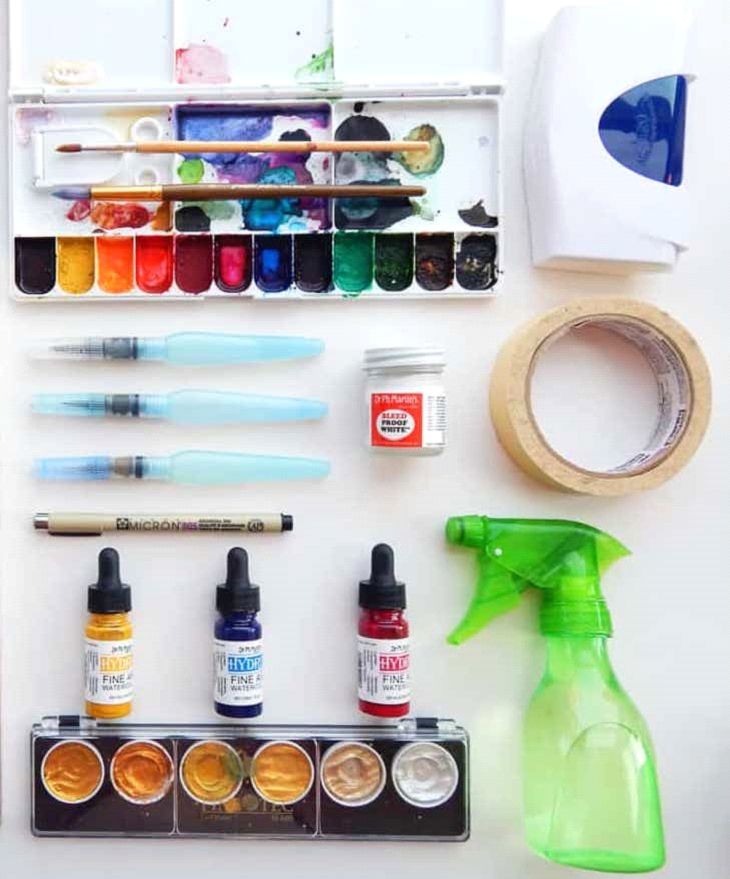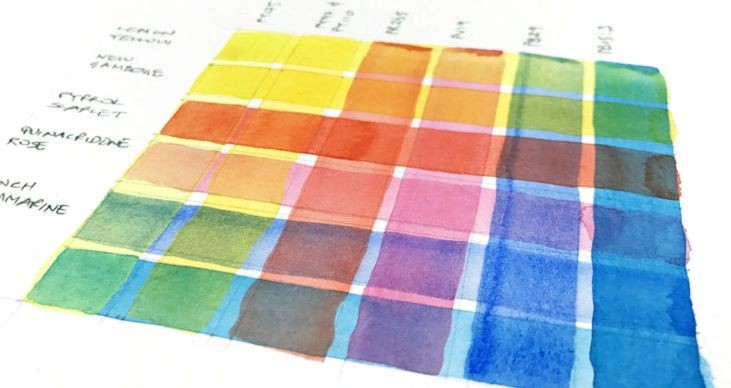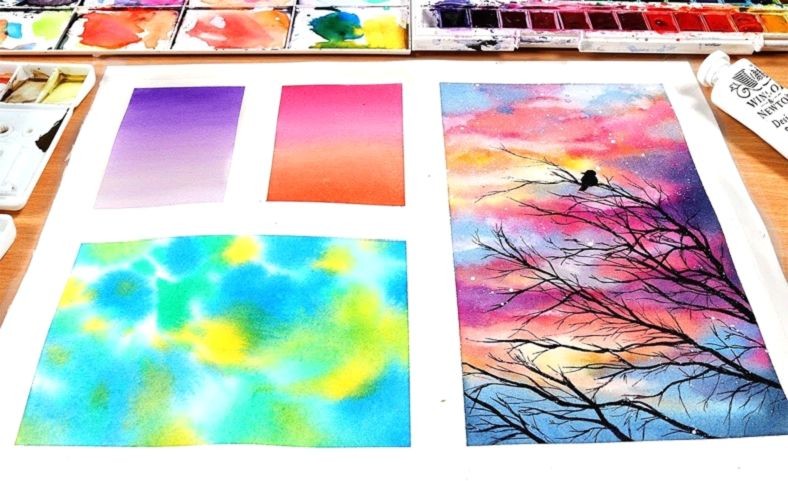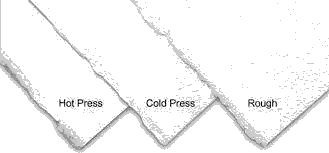
How to Use Watercolor?
By painting with watercolors you will discover new possibilities. For example, you can paint anything from a true-to-life portrait to abstract patterns. We have collected some tips on the topic watercolor for beginners as a tutorial for you. We hope that you will appreciate the art of watercolor painting.
How to Use Watercolor Paint for Beginners?
Artists around the world are very fond of watercolor paints. There are several reasons for it. With its help, any person, even without special artistic training, will be able to paint a picture. The painting process is so airy to laid-back.
At first glance, watercolor may seem like a very complex to deal with. But in truth, everything is much simpler. First, you need to learn how to treat the paint. First, take any sheet of paper and brushes. Wet the brush with water as well as paper. Then apply paint to it. After that, try to apply brushstrokes on a dry part of paper. You must not be afraid to leave blots. Just experiment!
Even beginner artists should have in his or her art studio the professional watercolor paints. They beautifully lay down on the ground unlike the cheaper analogs.
Materials

Let's talk about materials. Many beginners give up painting for one simple reason: because of poor-quality materials, the paint does not fit well, the paper spoils, and nothing happens. Therefore, despite the simplicity of the technique, the first lessons must be worked out under the guidance of a teacher-artist, and, of course, only professional materials should be used.
The variety of materials is really impressive. Semi-solid watercolor in half pens, paint in tubes, watercolor pencils, and even liquid watercolor, which is somewhat reminiscent of colored ink. Also, use natural brushes.
But more importantly, choose the right paper. After all, watercolor loves water, and therefore paper should be special. Depending on its quality and type, how the paint will lay down or spread, and with the help of a variety of textures, you can give the picture an interesting volume.
Do Not Be Afraid to Dirty!
Sooner or later you need to start trying to paint. Open a sketchbook and create interesting textures and stains in watercolor. If you will have previous experience you will not be afraid of canvases and watercolor paper. Make a start from lines and stains in search of a plot, applying first brushstrokes. Try to make the pages vibrant and disturbing. However, you may, vice versa, create calm, melancholic ornaments depending on your mood. So, it does not matter how to use watercolor paint in this situation. Besides, color or texture may suggest you the next step. To create a texture, you can use cling film. Attach it to the sheet in a curved form or press it with your fingers.
Watercolor paints are indeed more professional so you need to know how to use them for beginners, but they will also last longer. They get diluted better and therefore run out not so quickly.
Tip. Try to change the tools occasionally to find your favorite tool, technique, etc. Experiment with techniques and hues. Do not stop only on a few options; try as many techniques as possible.
By the way, if you create pencil sketches, you may add some accents to diversify it by using watercolor. However, you do not need to color the entire picture; sometimes several successful brush strokes create the most powerful effect.
Observe and Consider before Taking the Brush
You will paint more easily if you look closer at the objects structure. Observe it you see it for the first time in your life. Also, make some notes; look at it from different sides. Pay attention to the materials and how it shimmers in the sun. Besides, imagine what kind of shade it can have when being under the sunlight. For example, observe the spiral arrangement of leaves or curls along the stem.
Decompose it into different parts in your imagination as a puzzle. Find out which shape prevails. See the way details overlap. Also notice what a located closer to you and what is further. Besides, you may already imagine the background according to the hues that prevails on your object.
Learn to Mix Paints

You should learn through the experience thus mix colors to see the results. In such a away, one can learn all color mixing formulas. It is better to mix only two colors at first. When you got it, add the third color. Experiment again!
The number of possible hues has no limits. Each time, a slightly different hue can be obtained, depending on the number of one kind or another color. Do what you like. You can make either very realistic drawings or very non-trivial ones. The task is to collect paint which properties you will know and which will allow you to create the right hues with a good result.
Remember: you should paint from top to bottom. However, wait until it dries out and only then work out some additional details if necessary. It is recommended to use a large brush. Dilute the paint strongly with water. Put strokes in wide horizontal
Use Liquid Primer for Watercolor
Liquid primer for watercolor is used before the painting process, so in such a way you only prepare the paper to work. Besides, remove dried paint with its help as well. Mainly, you will benefit from it when working with intense pigment. However, before you did not know how to use watercolor with primer, practice in the sketchbook. The painting surface is much better for beginners in it, because canvas is quite slippery.
Use a damp brush or sponge if you have overstepped edges and want to remove paint from the parts where it is excess.
Learn the Art of Scumbling. It means obtaining deep iridescent colors. Artist can achieve it by applying translucent paints on top of previous layer of paint. Apply watercolor very delicately. For beginners it is useful to do it layer by layer. Moreover, the next layer is acceptable only when the previous one has completely dried out.
Watercolor Techniques

Due to such watercolors property as transparency, this type of liquid paint does not have strictly defined rules on the use. There are a huge number of techniques applied to different drawing styles. Let's look at the most basic.
- Differentiated Blur. This method is applicable while painting water, grass, sky. In general, it is the images of pastel elements. The idea is that you first need to soften the paper with water, and only then apply neat strokes from top to bottom. While working in such a technique, the artist gets the opportunity to experiment with different shades. However, you have to know how to use watercolor accordingly to the rules of this technique.
- Watercolor paintings techniques with salt are very popular too. There are many ways of using it, you can even think up your own. In short, it is used to convey movement, such as falling snow. Salt serves as a kind of additional effect that enlivens a picture, gives it dynamism. Also, artists can use it to depict the uneven rocky surface of the earth. However, everyone can try this method in different parts of the picture when drawing, for example, roofs of houses of roads.
- Dry brush. This method is not at all similar to the previous ones, since it involves working on almost dry paper. You should choose a hard brush, which you have to dip into the water, making sure that it remains almost dry. Images created with the help of such techniques are very similar to those that are drawn with a pencil.
What about the Ground?
No matter how good your skills are, and what techniques you know, but an ill-chosen ground can prevent you from realizing every idea you were going to draw.
If watercolor paints simply cannot do without water, then a paper can suffer greatly from such a “friendship” of paints and moisture. For instance, a ground can warp, tear. Therefore, when buying watercolor paints, you must choose the right paper.
It is worth saying right that there is no “bad” or “good” paper. It all depends on the intentions and style of the artist. For example, it makes no sense to buy absorbent rag paper if the technique involves multiple corrections (scrapings). Thus, you just ruin the surface by scratching it. Watercolor paper is available in our store for the artists. Naturally, you can order and try it.
What Paper to Choose for Watercolor Painting?

The paper itself can be factory-made and hand-made. Also, each one has its surface quality (smooth, semi-smooth, and rough). Watercolor paper has a high density, which allows using a large amount of liquid and that the paper does not tear.
With the help of watercolors, you can draw magnificent paintings on any subject, whether it be a portrait, a landscape, a quick sketch, a still life. Also, it has a unique texture and lightness, allowing you to create magnificent pieces of art.
We strongly recommend you to try and appreciate all the benefits of working with watercolor paints.
Add Extreme and Expression
Do not be afraid of bright colors and combinations. Sometimes accuracy is not as interesting as the individual vision of the artist. After drying, the watercolor becomes brighter. This feature should be considered when diluting the paint. Do not overdo it with the number of layers, otherwise, you risk losing the transparency, which is crucial for watercolor.
The maximum number of layers is three. Draw details with a thin brush, holding it strictly vertically. A stiff brush dipped in water will help erase the top layer of paint. This technique will help in drawing translucent or poor objects. But for this, you need to practice. For example, clouds are more realistic if you blur the background with a clean, large, damp brush. Watercoloring for beginners is not so simple, but interesting.